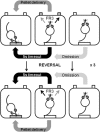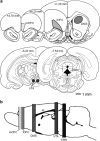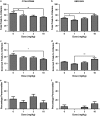Markers of serotonergic function in the orbitofrontal cortex and dorsal raphé nucleus predict individual variation in spatial-discrimination serial reversal learning
- PMID: 25567428
- PMCID: PMC4915245
- DOI: 10.1038/npp.2014.335
Markers of serotonergic function in the orbitofrontal cortex and dorsal raphé nucleus predict individual variation in spatial-discrimination serial reversal learning
Abstract
Dysfunction of the orbitofrontal cortex (OFC) impairs the ability of individuals to flexibly adapt behavior to changing stimulus-reward (S-R) contingencies. Impaired flexibility also results from interventions that alter serotonin (5-HT) and dopamine (DA) transmission in the OFC and dorsomedial striatum (DMS). However, it is unclear whether similar mechanisms underpin naturally occurring variations in behavioral flexibility. In the present study, we used a spatial-discrimination serial reversal procedure to investigate interindividual variability in behavioral flexibility in rats. We show that flexibility on this task is improved following systemic administration of the 5-HT reuptake inhibitor citalopram and by low doses of the DA reuptake inhibitor GBR12909. Rats in the upper quintile of the distribution of perseverative responses during repeated S-R reversals showed significantly reduced levels of the 5-HT metabolite, 5-hydroxy-indoleacetic acid, in the OFC. Additionally, 5-HT2A receptor binding in the OFC of mid- and high-quintile rats was significantly reduced compared with rats in the low-quintile group. These perturbations were accompanied by an increase in the expression of monoamine oxidase-A (MAO-A) and MAO-B in the lateral OFC and by a decrease in the expression of MAO-A, MAO-B, and tryptophan hydroxylase in the dorsal raphé nucleus of highly perseverative rats. We found no evidence of significant differences in markers of DA and 5-HT function in the DMS or MAO expression in the ventral tegmental area of low- vs high-perseverative rats. These findings indicate that diminished serotonergic tone in the OFC may be an endophenotype that predisposes to behavioral inflexibility and other forms of compulsive behavior.
Figures







References
-
- Abramoff M, Magalhaes P, Ram S (2004). Image Processing with ImageJ. Biophotonics International 11: 36–42.
-
- Aghajanian GK, Bunney BS (1977). Dopamine autoreceptors—pharmacological characterization by microiontophoretic single cell recording studies. Naunyn-Schmiedebergs Arch Pharmacol 297: 1–7. - PubMed
-
- Azmitia EC, Segal M (1978). Autoradiographic analysis of differential ascending projections of dorsal and median raphe nuclei in rat. J Comp Neurol 179: 641–667. - PubMed
Publication types
MeSH terms
Substances
Grants and funding
- G0001354/MRC_/Medical Research Council/United Kingdom
- MR/J012084/1/MRC_/Medical Research Council/United Kingdom
- 093875/WT_/Wellcome Trust/United Kingdom
- G1000183/MRC_/Medical Research Council/United Kingdom
- 104631/WT_/Wellcome Trust/United Kingdom
- G0701500/MRC_/Medical Research Council/United Kingdom
- 089589/Z/09/Z/WT_/Wellcome Trust/United Kingdom
- G0802729/MRC_/Medical Research Council/United Kingdom
- G1002231/MRC_/Medical Research Council/United Kingdom
- G1000183B/MRC_/Medical Research Council/United Kingdom
- 093875/Z/10/Z/WT_/Wellcome Trust/United Kingdom
LinkOut - more resources
Full Text Sources
Other Literature Sources
Research Materials

